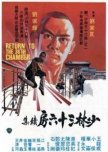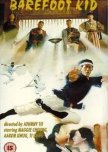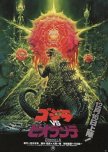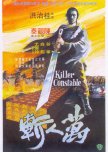
The story is fairly weak despite the aforementioned conflicts. Most of the intrigue introduced is an excuse to set up another fight scene. The movie's strength lies in it's numerous fight scenes. Summo wrestlers, ninjas, and your garden variety assassins show up from time to time to battle WFH and his merry band of kung fu warriors. Vincent Zhao does a good job as the high flying and noble Wong Fei Hung. His subordinates can be more of a detriment than an asset at times, both the characters and actors. The bad guys, even the femme fatale don't seem particularly menacing or much of a threat to WFH.
Warriors of the Nation is a perfectly enjoyable kung fu movie if you enjoy kung fu fights, don't mind a little wire-fu, and don't expect any character development or a cohesive storyline.
Was this review helpful to you?

Honestly, this movie annoyed me so much it's hard to write a review. I may never get Charlene Choi's screaming out of my head.
The basic plot is that an evil queen ruled the land with an iron fist. It's fantasy kung fu land where people can shape shift and use special powers. Donnie Yen showed up in a small role to find The Chosen One and also to find Excalibur so that the rightful male king could kill the queen and rule as was proper. He didn't have much to do with the exception of one big CGI enhanced fight with Jackie Chan in an even smaller role. What was the name of the character Donnie play? Crouching Tiger, Hidden Dragon. Again with the complete lack of originality.
One of the main leads was Jackie's son, Jaycee Chan, who was as interesting to watch as a wet blanket. Wilson Chen played his buddy, Blockhead. Don't laugh, Jaycee's character's name was Charcoal Head. One of these two doofuses was future royalty, if I'd been Donnie I would have had to reevaluate how bad the queen really was. Jillian Chung played the cold Blue Bird, it would only take a man to warm her heart. The aforementioned Charlene Choi played the Dumbell/male slave seller out to make money. The women were supposed to be skilled in martial arts, but at the first sign of trouble screamed and hid behind the men. A feminist's dream this movie was not, ultimately if any good came out of a situation it was because a man handled the problem.
The four main characters simply could not carry this movie due to the actors' limited skills. It reminded me of cheaply made fantasy television show where all the actors had to do was look pretty and wait for the stuntmen/stuntwomen to jump in and do the heavy lifting for the fight scenes. The scenery and sets were beautiful and you could tell the producers had sunk some cash into them. CGI and wire work were used extensively in the fight scenes with mixed results. In 2004 the CGI should have been better.
I'm sure I wasn't in the age demographic this movie was aimed at which may explain why it was so irritating to me. Your experience may vary depending on how many Chosen One stories you've seen and whether you find the leads attractive or likeable. For me the only scene that I found remotely entertaining was the fight between Donnie and Jackie and five minutes out of 105 hardly made it worth it.
Was this review helpful to you?

Scaffolding Kung Fu vs Bench Kung Fu!
Mantis, Tiger, Drunken, and Monkey kung fu…just when you think Lau Kar Leung might have run out of kung fu forms for choreographing martial arts scenes, he’s given the dream combo of Scaffolding kung fu vs Bench kung fu!Gordon Liu returned in this sort of sequel to The 36th Chamber of Shaolin. The third movie, Disciples of the 36th Chamber was actually a direct sequel to the original movie. This time he played a conman, Chao Jen Cheh, masquerading as Monk San Te in order to intimidate the new violent Manchurian overlords of the local cloth and dye factory. The Manchurians in charge bullied and beat their employees as well as reduced their worker’s pay to pad their own pockets. The only problem was, Chao didn’t know any kung fu and was soon found out which made the situation even worse for the workers. The people who had talked him into helping them begged him to go to the real Shaolin temple and learn kung fu so that he could come back and protect them.
Chao managed to maneuver his way into the Shaolin Temple but the real San Te saw through him instantly. After comic segments which went on too long for me, San Te put Chao to work building a scaffolding around the temple. Chao watched and learned from the monks as he practiced the drills while building the scaffolding, subconsciously developing his own form of kung fu. Three years later, he left the temple thinking he was a failure until he returned home. It turned out San Te’s covert method had taught him all he needed to know to handle the bullies. Admittedly his training smacked a little of Karate Kid’s “wax on, wax off” style of kung fu training but the final fights were entertaining enough to stretch my disbelief. It was only at this point that I started to enjoy the film. The fights were among some of the most creative, fun, and least deadly that I’ve seen. It was worth sitting through the rest of the film to watch Gordon Liu and Johnny Wang show their stuff.
I thought Gordon Liu showed a greater range of acting in this film. Chao not only learned kung fu, he also received the character development this unlikeable guy needed. Gordon Liu’s martial arts skills and moves were spectacular as always. I wait in anticipation for when he tears his shirt off and gets down to business. The less said about Hsiao Hou’s fake teeth and giant mole, the better. Johnny Wang only needed to look grim until it was time to fight, like a wrestler waiting to be tagged in.
Lau Kar Leung rarely disappoints with his direction and who would have thought bamboo ties could make such an effective kung fu weapon! Chao was faster than an elf wrapping packages for Christmas with his tying technique. While the great final act raised the score for me, it couldn’t completely erase the first half of the movie which dragged on too long for my taste. If you enjoy kung fu comedy you might enjoy this movie from beginning to end. If not, the last third of the film makes it worth watching.
Was this review helpful to you?

Dyeing to Know You Better
The Bare-Footed Kid started off sweet enough, turning darker with each new pair of shoes the shoeless youth acquired.Ti Lung played Tuan the noble, skilled fighter living undercover as a supervisor in a cloth dyeing shop. Maggie Cheung, Miss Ho, was the lovely owner of said shop with a secret dyeing technique and the den mother to her workers. These two had an underlying affection for each other that gradually made its way to the surface in a meaningful exchange. Tuan and Miss Ho were the heart of this film and the most compelling characters.
Aaron Kwok played Yuan, the titular character. Bare-foot, broke, and illiterate he came to town looking for his deceased father’s friend, Tuan. Yuan was naïve, but a ridiculously skilled fighter who couldn’t even write his own name which brought up some questions about how he was raised that are never answered. Enter Huang Lien as his love interest who was a teacher in her father’s school. Their budding romance had a rocky start and a rockier ending.
Yuan initially went to work for the kind Miss Ho, making missteps that landed him in the employ of the Big Bad. He earned a pair of stylish shoes, a pocketful of change and soon enough a heart full of regret.
The younger actors’ performances were fine as their characters went through life changes. Aaron Kwok made a sweet country bumpkin who was briefly led astray, his conscience weighing on him as reality sank in. Ti Lung and Maggie Cheung were a couple I never knew I needed as their subtle performances delivered an emotional impact that stayed with me.
Compared to older kung fu movies, the cinematography was excellent with beautiful scenery, lighting and colors. The score could be oddly synthetic at times but it wasn’t anything that distracted me much, I’ve heard much worse in these kinds of movies.
My biggest complaint, and what dropped the rating for me were the fight scenes. Ti Lung is a martial artist, one of those whose movements often needed to be slowed down for the camera. He also had a presence which made you believe he was nearly indestructible. I’m guessing Aaron Kwok’s skills, if he had any, were much more rudimentary, as his fight scenes included a lot of wire-work, possible doubling, speeding up, and blurry camera work, especially the huge concluding fight. One of my favorite martial arts choreographers, Lau Kar Leung, choreographed the fights. Whether he was compensating for the lead’s lack of ability, having an off day, or trying something new, I found the final fight to be hugely disappointing.
The Bare-Footed kid started out with some comedic moments ending as kung fu comedies often do, in heartbreak. Aside from the poor final fight which was brutal, this movie was entertaining. I could recommend it to kung fu enthusiasts with a few reservations.
Was this review helpful to you?

Godzilla vs a Giant Rose!
Godzilla’s biggest and most terrifying opponent is---- a giant rose bush? Breaking with the formula of Big G fighting his traditional opponents, the writers took a chance and invented Bolliante, the most creative Kaiju in the Godzillaverse.The biggest problem for me with this film was that it took a long time to gain any traction. The humans had a lot going on, dominating most of the story. One of the characters, a scientist, had fused Godzilla’s cells from a previous battle with a rose he’d already infused with his dead daughter’s DNA in hopes of keeping her soul alive, thus accidentally creating Bolliante. American terrorists and a Middle Eastern terrorist were running about killing people and trying to steal the Godzilla cells and super secrety secret nuclear energy eating microbes. In the process they free Godzilla from his volcano prison inside Mt. Mihara. Throw in a bunch of politicians who want to use all of the discoveries as weapons against Godzilla and their enemies and it’s a lot to take in. I can't forget the ESP students who can communicate with Godzilla and Bolliante. The young commander of the Super X-2 Godzilla fighting drone seemed superfluous most of the time with all the political maneuvering, scientists, terrorists, ESP folks, and agents running around.
None of the characters of this large cast were developed and the acting was lackluster at best. Without an emotional connection to the characters their deaths and decisions held little meaning. The military walking about and giving monotone orders wasn’t any more interesting than the spies chasing each other around.
What I liked about this movie---Big G looked good, I really liked this costume. Bolliante was a beautiful giant rose and then turned equally frightening. B was one of the more interesting and sympathetic antagonists for Big G. She was also the biggest and one of the most fearsome he'd ever faced. Historically speaking, Godzilla has had his hands full when facing a female opponent, Mothra for another example. This movie was darker and more violent than many other Godzilla movies. The fights were intimate and fierce, really well made using this technology.
The miniatures and pyrotechnics were spot on emphasizing the size and destructiveness of the great monsters tearing through the city. The music was best when using a few of Ifukube’s familiar Godzilla tunes.
Like a lot of Godzilla movies, this one had a moral to the story. This film focused on the hubris and greed of humanity and how man creates some of his own biggest problems. Godzilla and Bolliante weren’t the true monsters, it was the men and societies who created them. Plus, you’ll think twice the next time you walk into your garden.
Was this review helpful to you?

A widower who had worked away from home most of his career comes to find out that his idealized children and their lives are far more complex and complicated than he ever could have dreamed. In his desire to write a memoir based on the letters his wife sent through the years he discovers the distance between himself and his children is further than the kilometers that they live apart.
When none of his children come for the annual summer vacation at the family home after his wife’s death, he goes to surprise each one of them in the different cities where they live. All of their responses are less than enthusiastic for each is hiding a secret life. As the truth is revealed in the separate locales, they all repeat the same mantra they learned from the mother about concealing the truth from him so that he wouldn’t worry.
Most of the acting was very good in this film. Zhang Guo Li as the bewildered father who still sees his sons and daughters as small children in his mind did a superb job going from a rosy world to a more truthful reality. Shawn Dou, as the son who feels he was always the screw-up gave a heartfelt performance as well. The Swan Lake stop with the daughter who danced ballet was particularly poignant.
The only detraction from this movie were a few propaganda moments, especially a disparaging comment about Tibet.
Overall, I enjoyed this movie. The father learned the valuable lesson that when someone says they are fine, it usually means they are not, but don’t want to talk about it. The title truly sums up this family’s interactions with their father, but by erasing the façade and coming to terms with the fact that not everyone is fine, it opened the door to healing and closer relationships.
Was this review helpful to you?

The story had a nice mystery thread running through it, but the main plot tended to get lost in the weeds in the telling of it. One of the huge problems was that the fight scenes were often shot in the dark or had choppy editing. The director loved to have intense close ups and pull back--repeatedly. Polly and her double kept the action moving and it looked like fists and feet were landing shots. Li's kung fu looked like he was fighting three feet away from his opponents much of the time. Li Lung Hua was only in 8 films and if this film was any indication of his acting and kung fu talent he probably did need to find another career. I have to say, I laughed a lot while watching this movie, though I'm sure the filmmakers didn't intend for the audience to do so.
Lung Fei made a guest appearance as an assassin and a personal favorite, Lo Lieh, played one of the suspects in the murder case. These two helped make the movie more interesting for me, especially Lo Lieh. If Polly seemed overly animated it might have been because she was trying to infuse energy into her scenes with her lethargic co-star. Unfortunately, in the dubbed version I had to watch the voice over actress gave her a whiney voice. I'm pretty sure one voice actor must have voiced all the men and he made some curious choices at times to try and differentiate the characters.
A few of the fight scenes were creative including a contest on large iron balls. There are a couple of twists in the story to make things more interesting. Overall, it wasn't enough. In a kung fu film if the fights are not inspired and the actors are lacking in charisma no amount of jade arhats can save it. Only for fans of Polly or hard core kung fu fans.
Was this review helpful to you?

In this story, Godzilla didn’t die in 1954, only re-appearing in 1966 and 1996. It’s the same rubber suit from Godzilla 2000 though the stories don’t appear to be linked.
The scientists can’t figure out why Godzilla resurfaced after Japan went to completely clean energy sources eschewing nuclear and plasma energy. We as viewers know that Godzilla doesn’t come rampaging into town without a reason, but the afore-mentioned scientists decide to build a logic defying black hole weapon that is fired from space. I’m no scientist, but the “logic” behind a 2-meter black hole fired from a satellite would be enough to send real scientist Neil deGrasse Tyson on his own rampage.
I don’t need a rehash of Japan’s role in WW II and the US nuclear testing in the Pacific, but I do need a character to have a critical eye toward the bonkers deadly high tech they created to deal with Godzilla-a miniature black hole weapon fired from space that would contain him in another dimension? Forget Godzilla, think of the damage that such a weapon could cause to the planet or against other people, especially if something goes wrong or it’s enhanced. It’s the same dangerous hubris that caused Godzilla and his buddies to be created yet that point is completely ignored in this movie. Where is Dr. Serizawa when you need him? Godzilla didn’t come into town doing the Monster Stomp for no reason, better check out the secrety secrets going on with this version of the G-Force.
The miniatures were fine, there were creative miniature underwater scenes, and an aircraft that defied the laws of physics. The mix of regular scale, miniature scale, and CGI didn’t always transition smoothly but it was less jarring than other aspects in this movie.
One of the things I like about Godzilla movies is that there is usually a female character featured, sometimes sadly they are the reckless female reporter or someone added for scream affect. Kiriko was cold and emotionless and out for revenge against Godzilla, but a step up from said reckless reporter that has to be rescued type. Kudo, the tech geek was cute if not a great thinker outside of his inventions. I didn’t find the humans particularly interesting and honestly couldn’t root for them as they sought to kill Godzilla when it was their recklessness that caused him to attack in the first place. And any group stupid enough to unleash black holes as a weapon really needs to be eradicated. My loyalty is with Big G on this one.
A test black hole created a wormhole which let through Godzilla’s and Earth’s next foe---a giant dragonfly and/or egg. Again, no one asked whether the danger of using the weapon, letting something worse than Godzilla in, might be reason enough to not use it. While Megaguirus made a devious villain, the queen dragonfly didn’t get much screen time and neither did Godzilla. Her minions, the meganulon or smaller dragonflies made an appearance until Big G played Kaiju bug zapper to them. (They looked like the creatures from the original Rodan which killed a bunch of humans and also made a tasty treat for the hatchling Rodan.)
Aside from disregarding Godzilla’s past and the completely ridiculous pseudo-science, this movie made the cardinal sin of making me look at my watch wondering when it would be over. There wasn’t enough action or enough compelling human stories to keep my attention for much of the movie. Godzilla initially being swarmed by a bunch of the plane-sized dragonflies is annoying, I get it. How many times have I wished that I could fry mosquitos with my mind when they come after me? It took too long to get to the real menace and the real action. Once it did, the movie picked up but by then it was mostly over and the human’s smug use of an abomination of a weapon was all that was left.
Was this review helpful to you?

Bank of Seoul touches on the long hours salary men put into their jobs and how their lives, bodies, minds, and families suffer because of it. With the gift of not needing sleep and with the help of the Korean version of Red Bull he works around the clock to succeed and gain the promotion that had always seemed out of his grasp. Of course, the genie never gives a gift for free--what happens when the bill is due?
Most of the story centers directly on Seong Jae, played by Park Hee Soon. He gives a quiet performance of a man pushed to the edge of desperation and obsession.
The film is dark, both in mood and cinematography. Most of the shots are at night or under the cold glare of fluorescent bulbs.
Forty minutes was just about the right amount of time to tell Seong Jae's story as he and other sleep debtors strove to succeed and survive in a never ending night.
Was this review helpful to you?

I've seen reviewers compare it to Lord of the Rings and Indiana Jones. The plots in those films were laid out more clearly than this one and the characters were more fully developed. Though they relied on CGI and mythology they were also character driven. In this movie, Shu Qi's character felt plopped into the story with no background of where she came from, what her skill sets were, and much of anything about her except that she had been in a complex intimate relationship with Chen Kun's character. They dressed her like Lara Croft, but instead of being a badass she more often than not ended up at the mercy of someone else. We're given plenty of flashback scenes of Chen Kun's relationship with Angelababy which felt thin instead of like an epic or all consuming story of innocent love that would have haunted him for twenty years. It was strange to have all the romantic flashbacks while they are trying to make me care about his bickering relationship with Shu Qi. Sometimes I can just go along for the ride even when the story is all over the place but this was not one of those times. I didn't care for the side kicks at all, finding them more annoying than funny. The villains were completely lacking in spark for me as well as all the red shirts (Star Trek reference). And time and time again most of the characters behaved in illogical manners that caused many of the dangerous situations. Without their reckless behavior I suppose there wouldn't have been the opportunity for all the moments of once again escaping death with spectacular special effects.
The special effects were actually pretty good and there were plenty of scenes where they pulled out all the stops to display them. I just wish that I'd cared enough about the characters to feel a sense of tension when they were running for their lives or dangling by a thread. I don't mind the old tropes of booby trapped tombs, swarms of ravenous creatures, and buildings crumbling apart, just give me some people to care about as they save the world from destruction---again.
Was this review helpful to you?

I would only recommend this movie to completionists or people who enjoy early 1960's sci-fi movies. When Godzilla does a little dance after a fight and uses his boxing method, there's also little doubt this movie was not made for adults.
Godzilla and Rodan have almost nothing to do until the last three-tenths of the movie. Most of the movie explores the story of the aliens attempting to take over Earth which might not have been so bad if they hadn't tried to overtake humans by boring them to death. There was a plot to use Godzilla and Rodan in their conquest, but let's be honest, Godzilla moves pretty slowly, it was going to have to be a long game. The plot was thin and convoluted even for a Godzilla film from this era right up to the ending. A thin plot can often be overcome by some interesting monster action. Even in that area this movie failed as parts of the action scenes were recycled from earlier movies.
I may be a Big G fan but even grading on a curve like I do with all of his movies, this one was disappointing.
Was this review helpful to you?

The action choreography is not intricately laid out. The early fights were done at night making it almost impossible to see the action. Instead of it feeling claustrophobic, it was more frustrating. This is an ugly hack at each other with swords with blood spewing and body parts flying kind of fighting. Fire is used in some fights and bodies are shown badly burned. It’s a war of vicious attrition between the handful of constables and the seemingly endless supply of bandits. I fully expected KC to cry out a quote from another movie, “Worse! How could it get any worse? We’re at the threshold of hell!”
KC may have been self-righteous, loyal to his superiors and men, and utterly ruthless to his enemies, but his true enemies knew that and used it against him. In his narrow view of the world, he completely missed who the real enemy was.
I thought Ku Feng gave a particularly sympathetic performance as the father of a blind daughter who is being hunted by KC. Chen Guan Tai conveyed a range of emotions as an obsessive constable doing his duty, as a man who cares for his men and also as a man who tastes the bitter bile of betrayal. Director Kuei Chih Hung and writer Szeto On were able to make me care about these two characters who were not easy to care for.
While I can appreciate how this movie tried to show the bleak suffering of the times, I can’t say I particularly enjoyed it. I enjoyed the performances I mentioned. I prefer the lightning fast and well-choreographed fight sequences in other martial arts movies better than these slower fights. Without a clear-cut hero to root for or characters who are on screen long enough to be invested in them, I found myself unable to connect emotionally to most of the characters. Having said that, I can see why some people really like this movie and its bleak message, if you are a fan of martial arts movies, especially from this time and from this director, it is worth giving a try. For me, though a movie I’m not sorry to have watched, it’s one I won’t revisit.
Was this review helpful to you?

We are told somehow, somewhere, someway humans found a magical alien crystalline energy source in outer space and it transformed human society. We are told some alien Big Bads decided they wanted it and started attacking the earth. We are told about major cities being devastated world wide. We are told about loving longings between characters. We are told about friendships between characters. Another important thing this movie forgot---showing is more important than telling.
I found it utterly impossible to emotionally connect with any of the characters. Shu Qi is a beautiful and talented actress who was given the job of standing around looking at a monitor and giving orders. The four young pilots featured didn't have enough charisma or meaningful interactions with each other to have me invested in their lives or even remember who they were half the time. The rest of the cast acted in such a reserved manner as to feel almost lifeless.
Much of the CGI was good, even if the part of the alien spaceship they showed looked suspiciously like the ship from Independence Day. Too bad they forgot the part where we were shown what the actual aliens looked like from that movie, to make the battles seem even more personal and real. In Shanghai Fortress with all the amazing weaponry the humans had developed to combat the aliens, I'm at a complete loss why they still fought the alien robots on the ground using ineffective bullet shooting guns. There were several plot developments that made no sense.
Sometimes I can check my brain at the door and just enjoy the ride if the characters are compelling enough but this felt more like a hologram that was all visual with no substance.
Was this review helpful to you?

The characters were well rounded and even the supporting cast had weight and depth to them. The main leads had proper character development, unlike many cardboard cut-out characters from other martial arts movies.
Cheng Pei Pei was only 19-years-old and already she showed she could carry a movie. Though she lacked in fighting experience her grace and steely gaze made her character someone to be reckoned with when she drew her blades. A truly strong female lead who faced danger head on and dispatched her enemies on her terms. Yueh Hua was convincing as the Drunken Cat and leader of the beggar children who always showed up when needed and fought without fighting for the most part.
If I had one complaint, it was the number of musical scenes. I had to keep in mind that the songs were a subterfuge and means of passing along messages which would have made more sense to me the first time it happened if the copy I watched had subtitles for the songs.
The fight scenes were crude compared to later movie sword-fights but this was cutting edge at the time. Pei Pei's fight scenes were often stylized and dance-like, maybe not realistic but beautiful. Camera angles enhancing the actors' movements as well as attachment for the characters' well-being kept the fights interesting and also moved the story along. The story was well-written and was surprisingly well-layered.
The cinematography, sets, and costumes were definitely a notch above many of the wuxia movies from the time and even those that followed.
Come Drink with Me is an entertaining and well made movie, a worthy grandmother to Crouching Tiger, Hidden Dragon and other movies which benefited from it's storytelling.
Was this review helpful to you?

Most of the cast does a decent job of acting. The female lead gave it her all throughout the film and committed herself to the role. There were others who seemed to be reading their lines.
The biggest problem was with the production values. The first 10-15 minutes weren't bad. The cinematography and fights were okay. Then the quality plummeted. Some of the costumes and wigs were downright awful. The evil Japanese couple seeking to steal the list of corrupted officials from the swordswoman and the man she was protecting had wigs that looked like they came out of a bad comic strip. They tried speaking Japanese at one point and then gave up and went back to Mandarin. The evil eunuchs laid it on thick with the high pitched voices to the point it sounded like they'd breathed in helium before some scenes began. I rarely notice music unless it's really bad or really good. I noticed the music in this movie and it wasn't really good.
The movie played out like a wuxia sketch show complete with errors that no one bothered to correct. At one point an unconscious character lying in the road rolled away to avoid being hit by a carriage and then went back to being prone. The sword fights were slow, very slow and badly choreographed. Quite honestly, I laughed out loud several times during the movie at scenes that were not supposed to be funny.
Despite all the errors and bad fight choreography, there was an interesting story hidden beneath the rough appearance. The movie played out in earnest with many heroes and bad guys falling. Normally, I would have scored a modern movie of this quality lower, but because a swordswoman was prominently featured I gave it a little bump because a woman with a sword is my weakness. Unless you are looking to watch a very low budget wuxia you might want to give this one a pass.
Was this review helpful to you?

 54
54 195
195 11
11






















